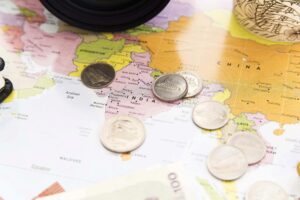
With the rise in popularity of thrift stores now that there is a recession throughout the world (unless you live in China), thrift stores have raised their prices, knowing that people are still desperate enough for cheaper clothes that they’ll be willing to buy there anyhow. And if not, thrift stores aren’t exactly lacking customers at the present time, so yes, prices do get hiked up. Oh well.
Thrift Store Shopping- the Thrifty Way
If you plan on thrift store shopping, here’s some tips that I’ve learned (unfortunately from experience) that will help cut the cost of your thrift store clothes shopping trips.
Thrift Store Sales
Many thrift stores have different sales on different days. I know in the store I used to shop in growing up there were different colored tags and each day different colored tags were half off. One day of the week, all clothes were half off. That’s the day my mom always took us shopping.
Some thrift stores have sales where they sell clothing by the pound or by the bag full. Before going thrift store shopping, call up the stores in your area and find out about their sales policy so you can time your trips accordingly.
Cheaper Stores
Not all thrift stores are equal. Some charge more and others less. Comparison shop- see which thrift stores are cheapest and go there first. If you need something specific and can’t find it in the cheaper store, by all means try the more expensive store, but save that one for last.
Thrift stores almost always don’t take returns. Make sure, therefore, that the clothing you buy will be good for you. Wasted money on clothes you won’t or can’t wear is still wasted money.
Make Sure the Clothes Fit
Many times thrift stores lack changing rooms. And sometimes tags are missing or are too faded. Finding correctly fitting clothes in the thrift shop can be challenging. To make sure the clothes you buy fit correctly:
- Bring along a skirt/pants and shirt that fit you well. Compare the size of the clothing from home with the clothes you find. This will help eliminate clothes that are completely the wrong size.
- Bring along “changing clothes”. When trying to change without a changing room, certain clothes can be worn to help you get changed “in public” while still remaining modest.
- A tighter fitting non bulky tee-shirt, either long or short sleeved, can be worn under your clothes when you go to the store. When you find a top that seems intriguing, go to a corner and remove your upper layer, leaving the tee-shirt on. Put the new shirt on top and check out the fit.
- A loose skirt can be put on top of skirts or pants you’re trying on, to keep you covered while you put on and remove the clothing. With practice, you’ll be able to do this easily without any passers by seeing a thing.
- Look once, look twice. How do the clothes make you feel? Great? Frumpy? Weird? Special? If you don’t feel terrific in the new clothes, you probably won’t wear them and they’re a waste.
- Take a shopping buddy. If at all possible, going shopping with a friend, especially someone with a good eye for fashion, is a great idea. You’ll save yourself the embarrassment of buying something outdated, unstylish, or unflattering for your figure. Make sure its a friend who isn’t afraid to speak her mind; no point hearing a white lie (“No, Penny, that skirt definitely does not make you look fat.”) if you’ll realize later on that the clothes aren’t suitable.
- Are the clothes old fashioned and outdated? Unless you’ve got talent like the NewDressADay.com lady, you probably don’t want to be wearing those (and even if you do, please, don’t. You’ll give the rest of us frugalistas a bad name.), so just skip ’em, and don’t buy ’em.
- Missing buttons? Sometimes there’s hidden buttons somewhere within the inside of the outfit, or there are extra buttons that can be moved around to where they’re needed. If there aren’t any, do you have any buttons at home that you can use to replace all the buttons? If you’re not sure how to replace the missing buttons, you might want to skip buying the outfit.
- Broken zipper? Some zippers are fixable. If not, replacing zippers is actually quite easy so long as you have a zipper foot on your sewing machine; buying new zippers can be more costly, especially if the zipper is long. Consider buying another “spare outfit” for the “spare zipper”- it may end up cheaper than buying a brand new zipper.
- Opened seams? These are the easiest to fix. Even without a machine, just a simple needle and thread (or even a safety pin or two) can do the trick in a few minutes.
- Stained? You can try to remove these, but I don’t bother. Its one thing to try to salvage an outfit you already have, and quite another to purchase something (even cheaply) that is stained, with the hopes of salvaging it.
- Fabric worn out? Unfortunately I don’t have a suggestion for this, and this is one situation in which I would absolutely not buy the clothes.
- Elastic ruined? Most elastic can be replaced easily, but sometimes its harder. Note where the elastic is and consider how much work it’ll be to replace. You may decide it isn’t worth the bother if the elastic is too complicated.




